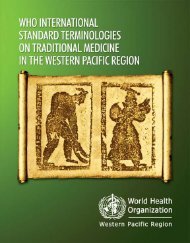Download pdf, 989kb - WHO Western Pacific Region - World Health ...
Download pdf, 989kb - WHO Western Pacific Region - World Health ...
Download pdf, 989kb - WHO Western Pacific Region - World Health ...
Create successful ePaper yourself
Turn your PDF publications into a flip-book with our unique Google optimized e-Paper software.
Sexual and Reproductive <strong>Health</strong> of Adolescents and Youths in Malaysia<br />
The FFPAM Youth Sexuality Survey<br />
covered 1303 respondents aged<br />
15-24 years of age from four states.<br />
Students (in-school adolescents) began<br />
dating at age 15, and the highest<br />
frequency was at age18, for both girls and<br />
boys. For out-of-school young people,<br />
the first age for dating was between<br />
18 to 20 years. The majority of in-school<br />
females (62.4%) had dated one to three<br />
males. A third had only dated one person.<br />
A maximum record of 10 partners was<br />
reported by 4.7% of the respondents.<br />
Some reported having 4-10 partners. Of<br />
the out-of-school young people, 40.4%<br />
of the females and 23.7% of the males<br />
had dated only one partner. The majority<br />
of those who had dated claimed “liking<br />
a person and wanting to know him/her<br />
better.” It was reported that “couples<br />
tended to be circumspect on their dates,”<br />
with the major physical contact being<br />
“holding hands”. Few had engaged in<br />
sexual intercourse.<br />
The findings regarding dating behaviour<br />
cannot be assumed to be very accurate,<br />
considering the sensitivity of the<br />
questions. Dating is an anathema to the<br />
old tradition of arranged marriages,<br />
which used to be common among all<br />
ethnic groups in Malaysia. The sensitivity<br />
becomes more apparent when the<br />
differentials between boys and girls are<br />
noted. Boys tend to claim they have been<br />
involved in such dating behaviour as<br />
necking and petting, while girls tend to<br />
deny such behaviour. The differences<br />
reported are not likely to be the pattern<br />
in reality, since they involve reciprocal<br />
behaviour involving both sexes. The<br />
urban-rural difference and the<br />
age-specific pattern are as expected, with<br />
more urban and older youngsters<br />
involved in each type of dating<br />
behaviour. The challenge to policymakers<br />
is obvious; if such types of<br />
behaviour are to be sanctioned based on<br />
cultural/religious grounds, and yet there<br />
is evidence that young people are<br />
engaged in them, what is the most<br />
appropriate response To disallow such<br />
behaviour would require the very<br />
arduous task of putting in place<br />
sanctions to be enforced and monitored,<br />
let alone assessing their consequences.<br />
However, freely allowing such behaviour<br />
and taking a liberal approach is also not<br />
appropriate or acceptable.<br />
(2) Age at sexual initiation (sexual<br />
debut) and sexual activity<br />
Data on age at first intercourse and<br />
incidence of sexual activity among<br />
adolescents are summarized in Table 5.<br />
The age at first intercourse (sexual debut)<br />
ranged from 9 to 24 years, with the<br />
highest frequency at 17-18 years. The<br />
percentage of young people who were<br />
sexually active ranged from 1% of<br />
adolescents aged 13 to 19 years<br />
30

















